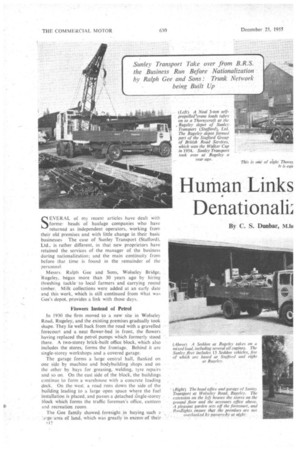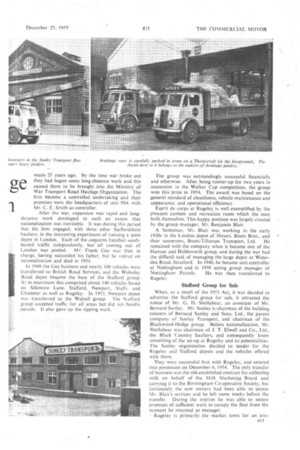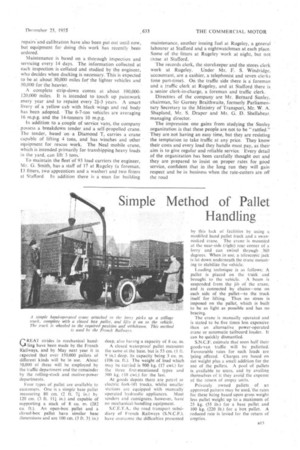Human Links ge Denationali;
Page 46

Page 47

Page 48

Page 49

If you've noticed an error in this article please click here to report it so we can fix it.
By C. S. Dunbar, min
SEVERAL of my recent articles have dealt with forme, heads of haulage companies who have returned as independent operators, working from their old premises and with little change in their basic businesses The case of Sunley Transport (Stafford), Ltd., is rather different, in that new proprietors have retained the services of the manager of the business during nationalization; and the main continuity from before that time is found in the remainder of the personnel.
Messrs. Ralph Gee and Sons. Wolseley Bridge, Rugeley, began more than 30 years ago by hiring threshing tackle-10 local farmers and carrying round timber. Milk collections were added at an early date and this work, which is still continued from' What was Gee's depot, provides a link with those days.
Flowers Instead of Petrol In 1930 the firm moved to a new site in Wolseley Road, Rugeley, and the existing premises gradually took shape. They lie well back from the road with a gravelled forecourt and a neat flower-bed in front, the flowers having replaced the petrol pumps which formerly stood there. A two-storey brick-built office block, which also includes the stores, forms the frontage. Behind it are single-storey workshops and a covered garage.
The garage forms a large central hall, flanked on one side by machine and bodybuilding shops and on the other by bays for greasing, welding, tyre repairs and so on. On the east side of the block, the buildings continue to form a warehouse with a concrete loading deck. On the west, a road runs down the side of the building leading to a large open space where the fuel installation is placed, and passes a detached single-storey block which forms the traffic foreman's office, canteen and recreation room. .
The Gee family showecl foresight in buying. such a Arge:area of land, which was greatly in excess-.of their ,112
needs 25 years ago. By the time war broke out they had begun some long-distance work and this caused them to be brought into the Ministry of War Transport Road Haulage Organization. The firm became a controlled undertaking and their premises were the headquarters of unit 9S4, with Mr. C. E. Smith as controller.
After the war, expansion was rapid and longdistance work developed to such an extent that nationalization was inevitable. It was during this period that the firm engaged, with three other Staffordshire hauliers, in the interesting experiment of running a joint depot in London. Each of the concerns handled southbound traffic independently, but all coming out of London was pooled. LW: Frank. Gee was then in charge, having succeeded his father, but he retired on nationalization and died in 1954.
In 1949 the Gee business and .nearly 100 vehicles were transferred to British Road Services, and the Wolseley Road depot became the base of the Stafford group. At its maximum this comprised about J40 vehicles based on Silkmore Lane, Stafford, Newport. Staffs. and Uttoxeter as well as Rugeley. In 1953, Newport depot was transferred to the Walsall group. The Stafford group accepted traffic for all Areas but did not handle parcels. It also gave up the tipping work.
The group was outstandingly successful financially and otherwise. After being runner-up for two years in succession in the Walker Cup competition, thegroup won this 'prize in 1954. The award was based on the general standard of cleanliness, vehicle maintenance and appearance, and operational efficiency.
Esprit de corps at Rugeley is well exemplified by the pleasant canteen and recreation room which the men built themselves. This happy position was largely created by the group manager, Mr. Benjamin Blair.
A Scotsman, Mr. Blair was working in the early 1930s in the London depot of Messrs. Bouts Bros., and their successors, Bouts-Tillotson Transport, Ltd. He remained with the company when it became one of the Hanson and Holdsworth group, and during the war had the difficult task of managing the large depot at Waterden Road, Stratford. In 1946, he became unit controller at Nottingham and in 1950 acting group manager of Nottingham Parcels. He was then transferred to Rugeley.
Stafford Group for Sale
' When, as a result of the 1953 Act, it was decided to advertise the Stafford group for sale, it attracted the notice of Mr. G. D. Shellabear, an associate of Mr. Bernard Sunley. Mr. Sunley is chairman of the building concern of Bernard Sunley and Sons, Ltd., the parent company of Sunley Transport, and chairman of the Blackwood-Hodge group. Before nationalization, Mr. Shellabear was chairman of J. T. Elwell and Co., Ltd., the Black Country hauliers, and consequently knew something of the set-up at Rugeley and its potentialities. The Sunley organization decided to tender for the Rugeley and Stafford depots and the vehicles offered with them.
They were successful first with Rugeley, and entered into possession on December 6, 1954. The only transfer of business was the old-established contract for collecting milk on behalf of the Milk Marketing Board and carrying it to the Birmingham Co-operative Society, but fortunately the new owners had been able to secure Mr. Blair's services and he left some weeks before the transfer. During the interim he was able to secure promises of sufficient work to occupy the fleet from the moment he returned as manager.
Rugeley is primarily the market• town for an area 813 which is half agricultural and half mining, and although there are a few factories in the neighbourhood and more coming, the nearest concentration of -industry is at Stafford, nine miles away. It was logical therefore to tender for the unit at Stafford as well.
The tender was successful and the depot and vehicles were taken over on May 23, 1955. The depot consists of a lug,: piece of waste land on which is a blister hangar and some wooden buildings. It reminds one of the early pioneering days of road transport when buildings took second place to vehicles in operators' minds. The hangar is used mainly for the storage of agricultural foodstuffs and fertilizers which are redistributed locally, and for servicing vehicles.
The new company's activities had first to be confined to tramping, and here Mr. Blair had his work cut out to fix up contact points at short notice. Wherever possible he asked his ex-B.R.S. colleagues to help, and friendly relations have been established with a number of B.R.S. depots which provide return loads. There has had to be a good deal of trial and error with returnload arrangements. Some clearing houses have been good at providing loads at economic rates; others have not been so satisfactory.
Back Loads the Bane This question of back loads is the bane of tramping. Before nationalization there was a growing tendency for tramping to diminish as hauliers found it best to concentrate on definite routes where they could arrange terminal facilities. The organization of trunk services which developed under nationalization was a logical Outcome of this tendency, but B.R.S. had one great advantage over any independent organization. It could accept a load for any destination with the knowledge that within a reasonable distance of the delivery point was a properly organized depot to offer a fair chance of a load for the way back.
The independent tramping haulier has no such organization behind him and consequently we are witnessing a situation exactly parallel to that of 30 years ago—a tendency for tramps to concentrate on the main traffic arteries and to obtain their back loads by cutting someone else's rate, if necessary. • Sunley Transport want to escape from this vicious and vulnerable position, and to base their activities on regular trunk services while at the same time giving customers facilities for deliveries to all parts of the country.
It is no use to try to start a trunk service without ensuring that the terminal facilities are right. Sunley's first aim had to be to secure. a London base, which has been arranged temporarily at 77 South Lambeth Road, the works of Bernard Sunley and Sons, and to engage Mr. W. Yeoman, formerly of Bouts-Tillotson's Welwyn Garden City office, as London representative.
" Tonnage Loads from Staffordshire It is intended to proceed on similar lines with other routes, particularly to South Wales, Liverpool and Glasgow, to which parts there is heavy traffic. The work handled outwards from Staffordshire is almost entirely tonnage, and consists of such traffic as reinforcing material for British Reinforced Concrete, electrical equipment for English Electric, oil engines for Dorman's, tyres front Goodyear and beer from Ind, Coope, as well as agricultural machinery, sanitary ware, door and window frames, heavy castings and paint.
Traffic back from London is more diverse and often consists of split deliveries. From South Wales steel is a14 the main traffic. The milk contract taken over from B.R.S. has been continued but with only nine vehicles instead of 20. Rates for this work are not attractive and it does not fit in with the type of business that Sunley's wish to develop.
B.R.S. system of documentation has been maintained with slight alterations. Instructions as received from customers are entered in an order book, and if not carried out on the day of entering are transferred to the next and re-entered in red.
Collection orders are made out in quadruplicate, three copies being handed to the collecting driver; one copy is left with the consignors and two go forward with the goods. One of these is left as a delivery note and the other is brought back signed. The fourth copy is retained in the office so that the accounts department has a check against the work done. From the order book a daily traffic summary is prepared for administrative and accounting purposes. Invoices are typed out in detail.
The premises at Rugeley will be adequate for many years to come, but the company have in mind greatly improving the primitive accommodation taken over from B.R.S. at Stafford. The town is an important road junction and as the Sunley facilities become better known, the Stafford depot is likely to grow in importance as a transhipment and distribution centre.
Fleet policy is to increase the number of eight • wheelers. to dispense with some of the 6-tonners and to replace them by articulated 10-tonners, which will be more suitable for such work as British Reinforced Concrete loads, for which long vehicles are required.
Far medium-sized loads the fleet will probably acquire Seddon and Thornycroft 6-7-tonners. The table shows the fleet make-up at October, 1955. At the take-over there Were 50 vehicles which coilld be used operationally at Rugeley (including a few in the B.R.S. category of " additional vehicles ") and 38 at Stafford, so that the total fleet shows a net increase of five vehicles. A number of the 5and 6-ton vehicles, including some with petrol engines. has been withdrawn and replaced by 7and 8-formers. All vehicles are open types. 7 The Stafford fleet was in poor condition when taken over, and heavy expenditure has been incurred in bringing it up to standard. The Rugeley fleet was in much better shape. Although work arising from accidents is often put out, so as not to interrupt the normal rhythm of maintenance, the undertaking is selfcontained except for crankshaft grinding. .Fuel-pump
repairs'and calibration have also been put out until now, but equipment for doing this work has recently been ordered.
Maintenance is based on a thorough inspection and servicing every 14 days. The information collected at each inspection is collated and studied by the engineer, who decides when docking is necessary. This is expected to be at about 30,000 miles for the lighter vehicles and 50,000 for the heavier.
A complete strip-down comes at about 100,000120,000 miles. It is intended to touch up paintwork every year and to repaint every 2i-3 years. A smart livery of a yellow cab with black .wings and red body has been adopted. The 6-7-ton vehicles are averaging 16 m.p.g. and the 14-tonners 10 m.p.g.
In addition to a couple of service vans, the company possess a breakdown tender and a self-propelled crane. The tender, based on a Diamond T, carries a crane capable of lifting 4 tons, and has winches and other equipment for rescue work. The Neal mobile crane, which is intended primarily for transhipping heavy loads in the yard, can lift' 3 tons.
To maintain the fleet.of 93 load carriers the engineer, Mr. G. Smith, has a staff of 17 at Rugeley (a foreman, 13 fitters, two apprentices and a washer) and two fitters
at Stafford In addition there is a man for building maintenance, another issuing fuel at Rugeley, a general labourer at Stafford and a nightwatchman at each place. Some of the fitters at Rugeley work at night, but not those at Stafford.
The records clerk, the storekeeper and the stores clerk
work at Rugeley. Under Mr. F. S. Windridge,• accountant, are a cashier, a telephonist and seven clerks (one part-time). On the traffic side there is a foreman and a traffic clerk at Rugeley, and at Stafford there is a senior clerk-in-charge, a foreman and traffic clerk.
Directors of the company are Mr. Bernard Sunley, chairman, Sir Gurney Braithwaite, formerly Parliamentary Secretary to the Ministry of Transport, Mr. W. A. Shapland, Mr. S. Draper and Mr. G. D. Shellabear: managing director.
The impression one gains from studying the Sunley organization is that these people are not to be "rattled." They are not having an easy time, but they are resisting the temptation to take traffic at any price. They know their costs and every load they handle must pay, as their aim is to give regular and reliable service. Every detail of the organization has been carefully thought out and they are prepared to insist on proper rates for good service, confident that in the long run they will gain respect and be in business when the rate-cutters are off the road




























































































